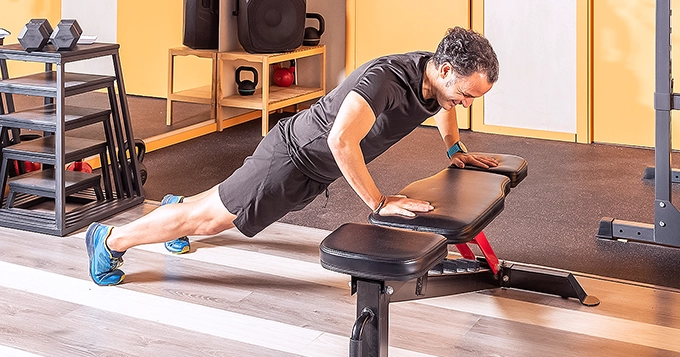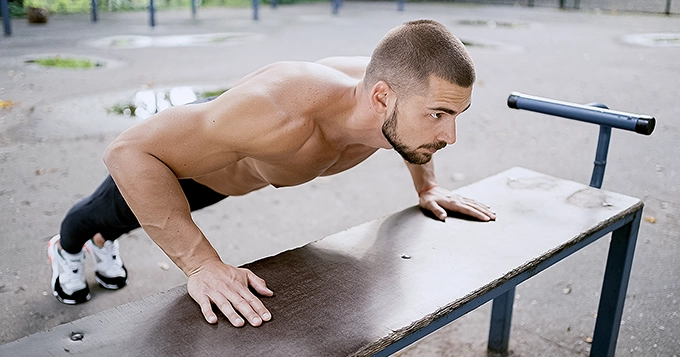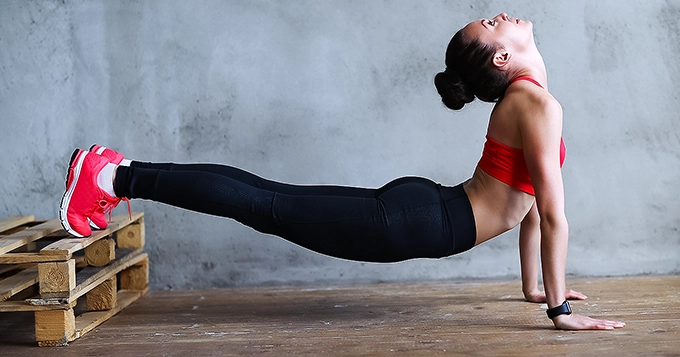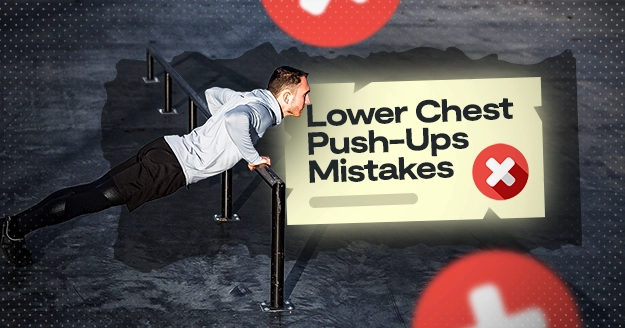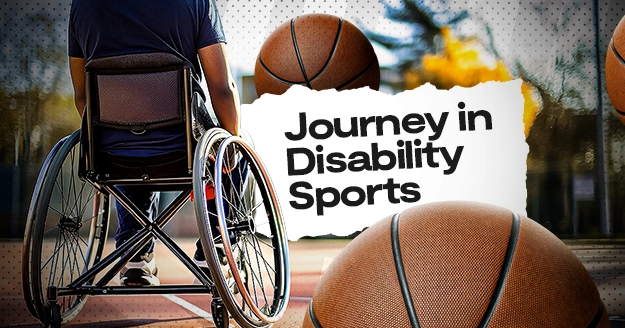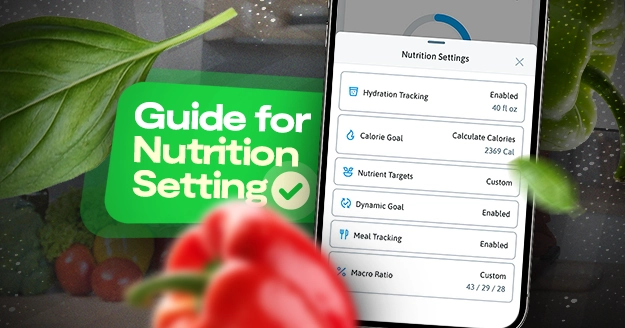Are you wondering how to get better at pushups so you can effectively target your lower chest? This article is for you.
What are Lower Chest Push-Ups?
Lower chest push-ups are an excellent exercise for targeting the lower part of your chest muscles.
The incline position redistributes more body weight onto the lower chest muscles, intensifying their workload during the exercise.
It’s a modified version of the classic push-up, which entails raising the upper body by placing the hands on an elevated surface like a bench, step, or wall, with the aim of targeting the lower chest. It’s not just great for working the lower chest, you can also do incline pushups for upper chest workout.
The lower chest push-up is ideal for beginners, those with limited mobility, or anyone recovering from an injury, as it reduces the weight on the upper body, making the exercise more manageable.
Lower chest push-ups effectively strengthen the chest, shoulders, triceps, and core muscles. They also promote better posture and stability and serve as an alternative for individuals who struggle with standard push-ups.
As one’s strength improves, they can progressively reduce the height of the elevated surface to intensify the challenge of the exercise.
Benefits of Lower Chest Push-Ups
Can be Done Anywhere
Lower chest push-ups offer versatility, as they can be performed nearly anywhere. All that’s required is a stable surface like a bench, step, or sturdy chair. This convenience allows individuals to easily integrate exercise into their daily routine, whether at home or in the gym.
Improves Posture
These pushups for the lower chest necessitate engaging the core muscles and sustaining proper form throughout the exercise. Strengthening the muscles that support your spine can enhance your posture and mitigate the risk of injury.
Increases Upper Body Stability
It also demands considerable upper body stability since the individual is balancing on an elevated surface. Regular exercise practice can enhance upper body stability, thereby improving performance in other exercises and activities that rely on upper body stability.
Reduce the Risk of Injury
Lower chest push-ups contribute to lowering the risk of injury by strengthening the muscles in the chest, shoulders, and arms. This increased strength can render the individual less prone to common upper body injuries like shoulder impingement or rotator cuff injuries.
Targets the Lower Chest Muscles
This variation of push-ups places greater emphasis on the lower portion of the chest muscles, intensifying their workload compared to traditional push-ups. This results in toning and strengthening the lower chest, fostering a more defined and sculpted appearance.
Common Errors and How to Avoid Them
To maximize the benefits and avoid setbacks, it’s crucial to steer clear of common mistakes. Here are some key blunders to dodge for effective lower chest push-ups:
- Incorrect Hand Placement
One mistake people make when doing lower chest push-ups is placing their hands too far from each other or too close together.
This error often leads to improper engagement of the abs or core, potentially causing undue strain on other muscles and joints.
Optimal hand placement should be slightly wider than shoulder-width apart to ensure proper engagement of your chest muscles. Avoid placing your hands too close to your body, as it can strain your wrists and shoulders.
- Improper Body Alignment
Maintaining proper body alignment is essential for effective lower chest push-ups. Your body should form a straight line from head to heels throughout the movement. Avoid arching or sagging your back, as it can lead to lower back pain and diminish the effectiveness of the exercise. Activate your core muscles in order to stabilize your body and maintain the correct alignment.
- Hips Too Low
Maintaining hip alignment with your shoulders throughout the entire push-up movement, from start to finish, is crucial. Allowing your hips to sag below your shoulders can lead to excessive extension in your lower back and ineffective use of your abdominal muscles for stabilizing your body.
- Elbows pointed out
One common mistake is allowing the elbows to point out to the sides during push-ups. This poor technique can lead to the head dipping towards the hands at the bottom of the push-up, which compromises form. Not only can this lead to shoulder discomfort, but it also indicates inadequate core control during the lowering and raising phases of the push-up.
Ideally, the elbows should be angled back towards the waist, with the shoulders meeting the hands at the bottom position of the push-up.
- Incomplete Range of Motion
Another mistake to avoid is performing partial lower chest push-ups with a limited range of motion. Ensure that you lower your body until your chest almost touches the floor, and then push back up to the starting position with full extension of your arms.
- Rapid or Jerky Movements
Many people rush through their lower chest push-ups with fast and jerky movements. This not only reduces the exercise’s effectiveness but also increases the risk of injury. Instead, focus on performing each rep with controlled and deliberate movements, emphasizing the contraction of your chest muscles throughout the exercise.
- Neglecting Proper Breathing Technique
Breathing plays a crucial role in any exercise routine, including lower chest push-ups. Avoid holding your breath or breathing irregularly during the exercise. Inhale as you lower your body towards your hands and exhale as you push back up to the starting position.
- Overlooking Warm-up and Cool-down
Skipping the warm-up and cool-down phases of your workout is a common mistake that can increase injury risk and hinder recovery. Before starting your lower chest pushup workout, spend a few minutes performing some dynamic stretches or light cardio to prepare your muscles for exercise. Likewise, after completing your workout, take time to stretch your chest muscles and cool down properly.
How to Do Lower Chest Push-Ups
Since you now know the things to keep in mind when performing lower chest push-ups, it’s time to learn how to actually do this exercise.
1. Position your feet on the floor and place your hands on an elevated surface (such as a table, chair, bench, or stair) slightly wider than shoulder-width apart.
2. Inhale while bending your elbows to lower your chest toward the elevated surface, ensuring your core and glutes remain engaged to maintain a straight line along the back of your body.
3. Exhale as you extend your arms and push straight upward, while continuing to contract your core and glutes.
4. Repeat the movement until your muscles reach fatigue.
Conclusion
Avoiding these key mistakes and focusing on proper form and technique are the secrets of how to get better at pushups, particularly for targeting your lower chest.
Remember to start slowly and go easy on yourself. Listen to your body’s signals, and gradually increase the intensity of your workouts over time. With your consistent effort and attention to detail, you’ll be well on your way to mastering the best lower chest push ups and building a stronger, more defined chest.
